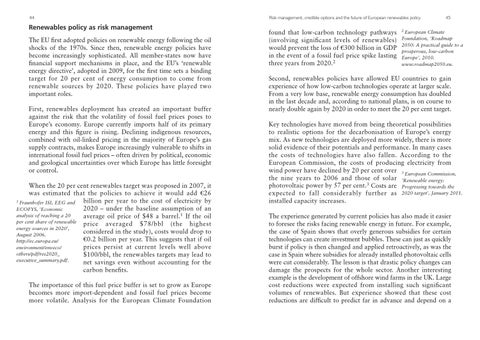44
Renewables policy as risk management The EU first adopted policies on renewable energy following the oil shocks of the 1970s. Since then, renewable energy policies have become increasingly sophisticated. All member-states now have financial support mechanisms in place, and the EU’s ‘renewable energy directive’, adopted in 2009, for the first time sets a binding target for 20 per cent of energy consumption to come from renewable sources by 2020. These policies have played two important roles. First, renewables deployment has created an important buffer against the risk that the volatility of fossil fuel prices poses to Europe’s economy. Europe currently imports half of its primary energy and this figure is rising. Declining indigenous resources, combined with oil-linked pricing in the majority of Europe’s gas supply contracts, makes Europe increasingly vulnerable to shifts in international fossil fuel prices – often driven by political, economic and geological uncertainties over which Europe has little foresight or control. When the 20 per cent renewables target was proposed in 2007, it was estimated that the policies to achieve it would add S26 1 Fraunhofer ISI, EEG and billion per year to the cost of electricity by 2020 – under the baseline assumption of an ECOFYS, ‘Economic analysis of reaching a 20 average oil price of $48 a barrel.1 If the oil per cent share of renewable price averaged $78/bbl (the highest energy sources in 2020’, considered in the study), costs would drop to August 2006. S0.2 billion per year. This suggests that if oil http://ec.europa.eu/ prices persist at current levels well above environment/enveco/ others/pdf/res2020_ $100/bbl, the renewables targets may lead to executive_summary.pdf. net savings even without accounting for the carbon benefits. The importance of this fuel price buffer is set to grow as Europe becomes more import-dependent and fossil fuel prices become more volatile. Analysis for the European Climate Foundation
Risk management, credible options and the future of European renewables policy
found that low-carbon technology pathways (involving significant levels of renewables) would prevent the loss of S300 billion in GDP in the event of a fossil fuel price spike lasting three years from 2020.2
45
2
European Climate Foundation, ‘Roadmap 2050: A practical guide to a prosperous, low-carbon Europe’, 2010. www.roadmap2050.eu.
Second, renewables policies have allowed EU countries to gain experience of how low-carbon technologies operate at larger scale. From a very low base, renewable energy consumption has doubled in the last decade and, according to national plans, is on course to nearly double again by 2020 in order to meet the 20 per cent target. Key technologies have moved from being theoretical possibilities to realistic options for the decarbonisation of Europe’s energy mix. As new technologies are deployed more widely, there is more solid evidence of their potentials and performance. In many cases the costs of technologies have also fallen. According to the European Commission, the costs of producing electricity from wind power have declined by 20 per cent over 3 European Commission, the nine years to 2006 and those of solar ‘Renewable energy: photovoltaic power by 57 per cent.3 Costs are Progressing towards the expected to fall considerably further as 2020 target’, January 2011. installed capacity increases. The experience generated by current policies has also made it easier to foresee the risks facing renewable energy in future. For example, the case of Spain shows that overly generous subsidies for certain technologies can create investment bubbles. These can just as quickly burst if policy is then changed and applied retroactively, as was the case in Spain where subsidies for already installed photovoltaic cells were cut considerably. The lesson is that drastic policy changes can damage the prospects for the whole sector. Another interesting example is the development of offshore wind farms in the UK. Large cost reductions were expected from installing such significant volumes of renewables. But experience showed that these cost reductions are difficult to predict far in advance and depend on a
